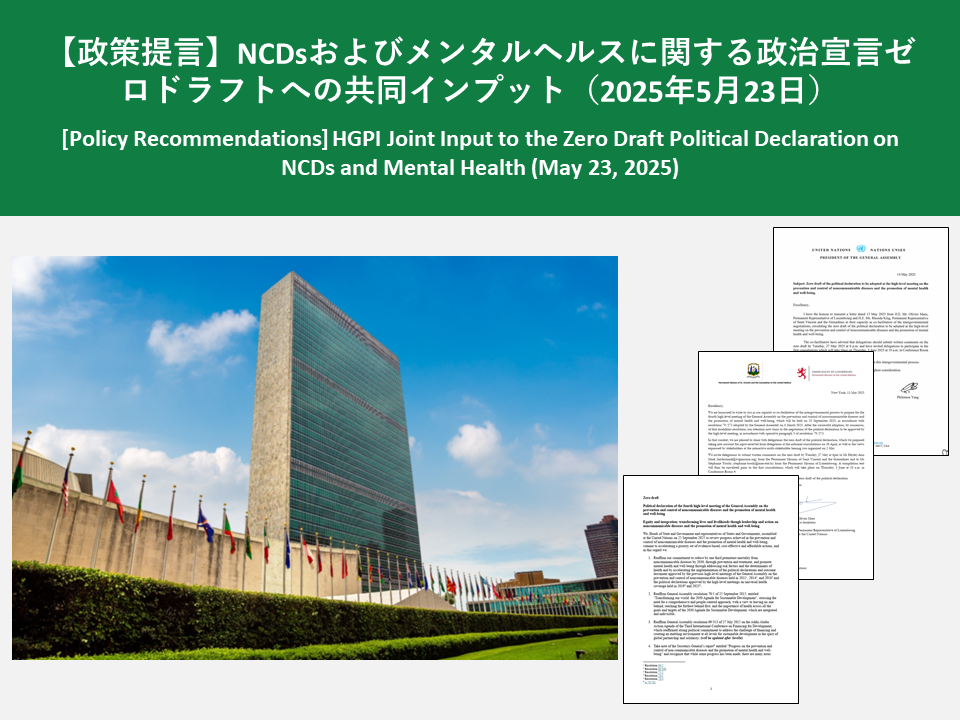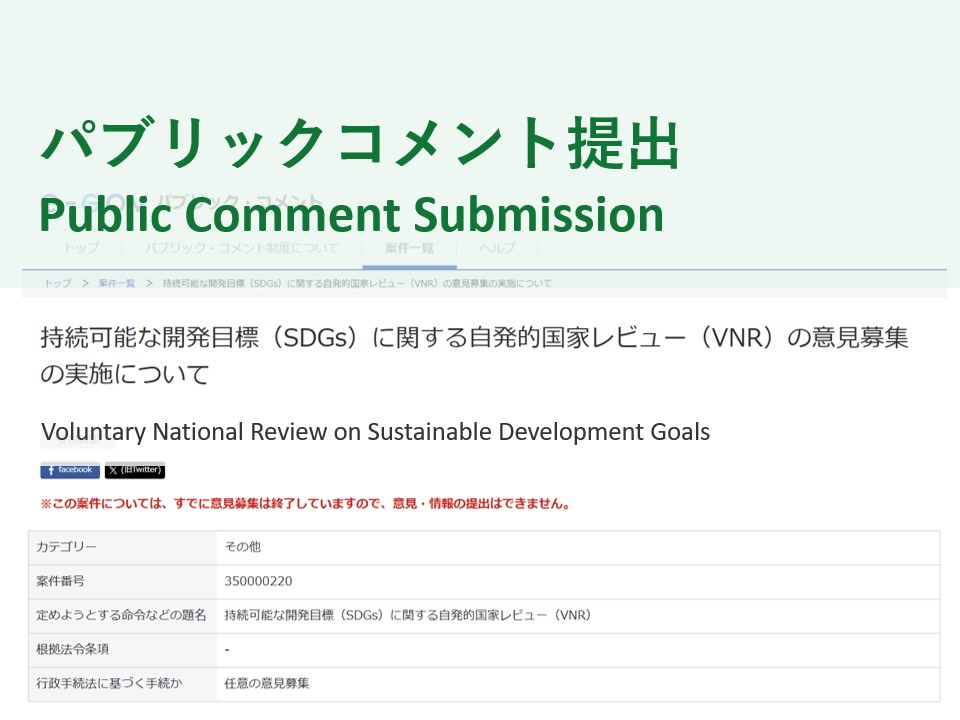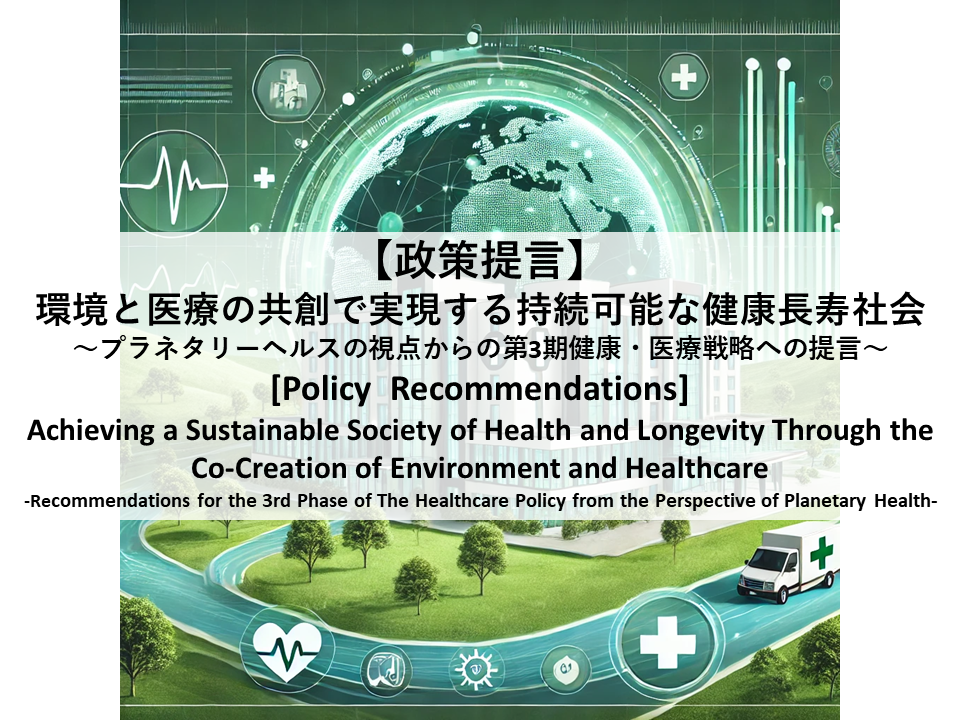[HGPI Policy Column] (No. 60) — From the Planetary Health Project “Part 14: International and Domestic Perspectives on Biodiversity and Health Policy Trends”
date : 6/4/2025
![[HGPI Policy Column] (No. 60) — From the Planetary Health Project “Part 14: International and Domestic Perspectives on Biodiversity and Health Policy Trends”](https://hgpi.org/en/wp-content/uploads/sites/2/HGPI_Column_Biodiversity_20250605.jpg)
<POINTS>
- Policy discussions on “biodiversity and health” have accelerated globally since COVID-19, with the “One Health” perspective increasingly integrated into national biodiversity strategies.
- Internationally, in addition to the adoption of the Kunming-Montreal Global Biodiversity Framework (GBF), the Global Action Plan to integrate biodiversity and health has been developed, with its promotion confirmed at the CBD-COP16.
- In Japan, the “National Biodiversity Strategy 2023-2030” explicitly links ecosystem services to human health, and promotes integrated efforts such as the conservation of Satoyama-Satoumi landscapes and registration of Nationally Certified Sustainably Managed Natural Sites.
Introduction
In recent years, international policy discussions emphasizing the interconnection between biodiversity and health have advanced rapidly. Especially since the COVID-19 pandemic, a shared global recognition has emerged that biodiversity loss increases the risk of infectious disease outbreaks. This has repeatedly underscored the necessity of integrated approaches combining environmental and health policies. This edition of the Planetary Health Policy Column outlines recent international and domestic trends in biodiversity and health policy and discusses future prospects.
International Trends on Biodiversity and Health
- IPBES Report and Warnings on Health Risks
The Global Assessment Report on Biodiversity and Ecosystem Services (hereinafter referred to as the “IPBES report”) by the Intergovernmental Science-Policy Platform on Biodiversity and Ecosystem Services (IPBES) published in 2019 analyzed the link between the natural environment, including biodiversity and ecosystem services, and human well-being based on scientific evidence. The report has been serving as a foundation for subsequent international policy formation. It highlights severe degradation of ecosystems due to deforestation, agricultural expansion, and climate change, placing over one million species at risk of extinction. This has revealed that the loss of ecosystem services directly impacts on human physical and mental health.
Of particular note is the point that many of nature’s contributions to people (NCP) are indispensable for human health and that their deterioration threatens good quality of life. NCPs include a wide variety of benefits such as diverse and nutrient-rich food and medicine, clean water supplies, regulation of epidemics and the immune system, reduction of certain air pollutant levels and improved physical and mental health through contact with nature. Their decline therefore undermines people’s benefits, directly or indirectly affects public health, and may further increase existing inequalities with regard to access to healthcare, healthy food, etc. The IPBES report warns of these risks and emphasizes the need for integrated policy-making that reflects the interdependence of biodiversity and public health.
- COVID-19 and Policy Shifts in Environmental Protection
The COVID-19 pandemic, which emerged in 2020, served as a striking real-world validation of the risks highlighted in the IPBES report. In the same year, IPBES released a special workshop report examining the connection between pandemics and biodiversity, emphasizing the need for transformative policy options to promote societal change and enable prevention and control of future pandemics. In 2022, several leading international organizations, i.e., the Food and Agriculture Organization of the United Nations (FAO), the United Nations Environment Programme (UNEP), the World Health Organization (WHO), and the World Organisation for Animal Health (WOAH), jointly launched the One Health Joint Plan of Action. Presented at the World Health Summit in October of that year, this initiative was significant in that it expanded the existing tripartite collaboration (FAO, WHO, WOAH) to include UNEP. The plan conducts analysis and research on the environmental determinants of health risks, including climate change, land-use change, and environmental degradation. As a result, the One Health approach has increasingly become central to international consensus as a global framework integrating environmental, animal, and human health. This policy alignment significantly influenced the negotiations at the 15th meeting of the Conference of the Parties to the Convention on Biological Diversity (CBD-COP15), held in Montreal in December 2022. There, around 190 countries reached a broad consensus to protect 30% of the Earth’s land and sea by 2030 and implement multiple countermeasures against biodiversity loss.
Following this momentum, policy discussions within the CBD framework have begun to explicitly connect biodiversity conservation with infectious disease prevention, public health promotion, and the reduction of health disparities. The integration of environmental and health policies is thus expected to advance further as an approach that also aligns with the Sustainable Development Goals (SDGs).
- Adoption of the Global Biodiversity Framework and Supplementary Health Measures
Influenced by the impact of COVID-19, the international community accelerated the development of a new global policy direction for biodiversity: the Kunming-Montreal Global Biodiversity Framework (GBF). This framework was officially adopted at the CBD-COP15. It includes the “30by30” target, which aims to conserve 30% of terrestrial and marine areas by 2030, and envisions reaching the global vision of a world that lives in harmony with nature by 2050. Although the GBF includes references to human health, challenges remain regarding the concrete policy tools and implementation mechanisms needed to realize these objectives.
- Development of the Global Action Plan on Biodiversity and Health
In response, the Global Action Plan on Biodiversity and Health was introduced. This action plan is positioned as a complementary document to the health components of the GBF and serves as a guideline for countries to take specific actions such as reducing infectious disease risks, developing urban green spaces, regulating wildlife trade, and protecting genetic resources essential for pharmaceutical development. The draft of the action plan was prepared in 2023, and negotiations for its formal adoption took place at the CBD-COP16, held in Cali, Colombia, in October 2024. While the plan is considered a voluntary framework and does not carry legal obligations, it plays an important role in enhancing the effectiveness of the GBF’s 23 targets. Key institutions such as UNEP and WHO have expressed full support for this initiative.
The action plan is structured around four main pillars: first, the introduction of health impact assessments in land-use planning; second, strengthening disease surveillance in areas experiencing rapid habitat loss; third, stricter regulation of wildlife trade; and fourth, the protection and equitable benefit-sharing of genetic resources and digital sequence information essential for pharmaceutical development. In addition, the plan incorporates provisions related to the misuse and improper disposal of antibiotics, as well as responses to health hazards posed by chemical substances and pesticides. As such, it is widely regarded as a comprehensive and pragmatic roadmap. However, at the CBD-COP16, disagreements persisted over whether these measures should be made mandatory or remain voluntary. Tensions arose between developed and developing countries, and between the pharmaceutical industry and public health sectors. While the action plan received broad support and its advancement was affirmed, its formal adoption has been postponed and is now expected to take place in 2025 or later.
Domestic Trends on Biodiversity and Health
Alongside the discussions deepened internationally, Japan has also seen an acceleration in policy development aimed at integrating biodiversity and health. Triggered particularly by the COVID-19 pandemic, there has been a growing public and institutional awareness of the interdependence between the natural environment and human health. As a result, initiatives to incorporate health considerations into environmental policy have been promoted across multiple levels—including national and local governments, private enterprises, and civil society. Furthermore, catalyzed by the global momentum surrounding the adoption of the GBF, Japan has begun formulating and implementing policies that approach biodiversity conservation and health promotion in a more integrated manner. These efforts are steadily evolving into comprehensive strategies that bridge both environmental and public health domains.
- Revision of the National Biodiversity Strategy and the Introduction of a New Health Perspective
Against this backdrop, Japan’s National Biodiversity Strategy 2023–2030, approved by the Cabinet in March 2023, serves as the foundation of the country’s biodiversity policy. It aligns with the Kunming-Montreal Global Biodiversity Framework (GBF) and advances the global vision of achieving a “nature-positive” world, defined as halting and reversing nature loss by 2030 on a 2020 baseline and achieving full recovery by 2050. Notably, the strategy explicitly incorporates health-related elements, reaffirming that biodiversity forms the foundation of human life, health, and security.
The strategy emphasizes the “sustainable enjoyment of ecosystem services,” highlighting how various ecosystems, such as forests, wetlands, oceans, and farmlands, contribute to human health. Scientific evidence has shown that green spaces and parks in urban areas play a role in mitigating the urban heat island effect, improving air quality, and providing psychological restoration, thereby promoting health of residents. In addition, the strategy outlines efforts to reduce pesticide use and minimize chemical exposure as means to prevent negative impacts on public health.
Another noteworthy focus of the National Biodiversity Strategy 2023-2030 is the conservation and utilization of Satoyama and Satoumi landscapes, i.e., traditional socio-ecological systems in rural Japan. Historically, practices such as managing firewood forests, cultivating rice terraces, and using seaweed beds and tidal flats have supported biodiversity while shaping healthy lifestyles for local residents. These traditional landscapes are now being re-evaluated, supported by growing evidence that contact with nature contributes to both physical and mental health.
Indeed, across Japan, a growing number of initiatives, including forest therapy, nature tourism, and community-based environmental education, are helping restore human–nature relationships and generate “co-benefits” that ensures health promotion and environmental conservation. In particular, depopulated rural areas are now seeing the emergence of model projects that link local communities with healthcare and welfare systems to build comprehensive regional strategies for living in harmony with nature.
- Promotion of 30by30 Target and registration of Nationally Certified Sustainably Managed Natural Sites
Following the CBD-COP16 held in Cali, Colombia, Japan has also initiated efforts to achieve the “30by30” target which aims to conserve 30% of the country’s land and marine areas by 2030. However, since existing legally designated areas such as national parks and natural parks alone cannot meet this target, the government is also encouraging the private sector to register forests and green spaces under their management. Internationally, such areas are referred to as OECMs (Other Effective Area-Based Conservation Measures), while in Japan, they are recognized as “Nationally Certified Sustainably Managed Natural Sites.”
The Ministry of the Environment is actively calling for registrations not only from corporations but also from a wide range of stakeholders, including universities, local governments, and public and research institutions. As of April 2025, a new law, “the Act on Promoting Activities to Enhance Regional Biodiversity”, has come into effect, providing a legal framework for Nationally Certified Sustainably Managed Natural Sites and accelerating their designation across the country. As global momentum builds toward achieving the GBF’s targets, Japan could witness a rise in biodiversity-related legal requirements. For example, stricter environmental constraints may be imposed at manufacturing sites to reduce the impact of pollutants. In addition to awareness-raising initiatives, responding to the GBF as a national strategy may be translated into new regulatory measures. However, these developments are not only challenges, but also create opportunities for innovation in environmental technologies and the emergence of new business models. For instance, under the Ministry of the Environment’s “Transition Strategies toward Nature Positive Economic,” biodiversity conservation is considered a driver of enhanced corporate value and the development of new markets. Furthermore, companies that support Nationally Certified Sustainably Managed Natural Sites are eligible to receive official certificates from the Ministry, which serve as a formal recognition of their contribution to ecosystem restoration. These measures aim to harmonize environmental protection with economic development, offering companies a new pathway toward sustainable growth.
- Introduction and Utilization of Green Infrastructure
In Japan, the adoption and utilization of “green infrastructure” is gaining attention as a policy approach that simultaneously supports biodiversity and human health. Green infrastructure refers to the strategic use of nature’s multifaceted functions, such as water infiltration, temperature regulation, scenic value, and provision of habitats, as components of social capital. It is also an approach that delivers multiple benefits at once, including biodiversity conservation, climate change adaptation, and enhancement of public health and well-being.
Since 2015, the Ministry of Land, Infrastructure, Transport and Tourism (MLIT) has promoted green infrastructure through initiatives such as establishing “the Green Infrastructure Public-Private Platform” and incorporating natural environments into urban planning and infrastructure development. In 2020, the MLIT released the “Green Infrastructure Promotion Strategy,” which explicitly highlights the benefits of using urban green spaces and waterside spaces for heat island protection, disaster prevention and mitigation, improving local attractiveness and promoting health. Additionally, MLIT has begun collaborating with the Ministry of Health, Labour and Welfare and the Ministry of the Environment to integrate green infrastructure with policies for community-based care systems and the extension of healthy life expectancy among older adults. On the municipal level, specific initiatives include creating walkable cities, developing health-oriented parks, and establishing nature observation trails.
Future Prospect and Challenges
Although Japan’s integrated policies on biodiversity and health are grounded in national strategies, several challenges persist in the implementation phase. For instance, addressing the health risks associated with pesticides and chemical substances requires both scientific and institutional responses, such as coordinating with agricultural and forestry sectors, tightening regulations, and promoting alternative technologies, just to name a few. Furthermore, land-use planning issues related to green infrastructure and 30 by 30, such as securing green spaces in urban areas, remain unresolved, raising questions about how to advance spatial and policy measures to address them. Equally important is the development of indicators and monitoring systems to evaluate the relationship between nature and health. Metrics such as urban green coverage ratios, air quality levels, and assessments of how natural environments alleviate residents’ stress and anxiety are indispensable for evidence-based policymaking. Currently, efforts are underway involving collaboration among national and local governments and research institutions to collect both quantitative and qualitative data related to nature and health across different regions. These data are expected to serve as a crucial foundation for future policy formulation.
Conclusion
Internationally, the formulation of the Global Action Plan and the discussions held at the CBD-COP16 have presented a new policy framework linking biodiversity and health. Domestically, Japan has also made steady progress in advancing an integrated approach through national strategies, local government initiatives, conservation of Satoyama and Satoumi landscapes, and development of Nationally Certified Sustainably Managed Natural Sites.
Looking ahead, a critical challenge will be how to ensure that these efforts are both sustainable and effective, while balancing them with the livelihoods and economic activities of local communities. Biodiversity and health is no longer a topic of interest limited to specialists, but it is a fundamental issue that concerns the daily lives and future well-being of all people. The evolution of policymaking and broader public participation will be key to realizing a society where nature and health coexist in harmony.
References
- Intergovernmental Science-Policy Platform on Biodiversity and Ecosystem Services. (2019). Global assessment report on biodiversity and ecosystem services. https://ipbes.net/global-assessment (Accessed June 2, 2025)
- Intergovernmental Science-Policy Platform on Biodiversity and Ecosystem Services. (2020). Workshop Report on Biodiversity and Pandemics of the Intergovernmental Platform on Biodiversity and Ecosystem Services. https://ipbes.net/pandemics (Accessed June 2, 2025)
- Food and Agriculture Organization, United Nations Environmental Programme, World Health Organization, & World Organization for Animal Health. (2022). One Health Joint Plan of Action (2022–2026). Working together for the health of humans, animals, plants and the environment. https://doi.org/10.4060/cc2289en (Accessed June 2, 2025)
- United Nations. (2024). Biodiversity COP16: Important agreement reached towards goal of making peace with nature. https://www.un.org/sustainabledevelopment/blog/2024/11/biodiversity-cop-16-important-agreement-reached-towards-goal-of-making-peace-with-nature-2/ (Accessed June 2, 2025)
- Convention on Biological Diversity. (n.d.). Kunming-Montreal Global Biodiversity Framework. https://www.cbd.int/gbf/ (Accessed June 2, 2025)
- Health Policy Watch. (October 26, 2024). Nations Deadlocked Over Health-Biodiversity Framework at COP16. https://healthpolicy-watch.news/nations-deadlocked-over-health-biodiversity-framework-at-cop16/ (Accessed June 2, 2025)
- Ministry of Foreign Affairs. (November 5, 2024).
- Sixteenth Meeting of the Conference of the Parties to the Convention on Biological Diversity, etc. (Summary of results). https://www.mofa.go.jp/mofaj/ic/ge/pagew_000001_01063.html (Accessed June 2, 2025)
- Ministry of the Environment. (n.d.). Certificate of Support for nature-friendly sites. https://policies.env.go.jp/nature/biodiversity/30by30alliance/kyousei/certificate/ (Accessed June 2, 2025)
- Ministry of the Environment. (March 31, 2023). National Biodiversity Strategy 2023-2030. https://www.env.go.jp/content/000124381.pdf (Accessed June 2, 2025)
- Ministry of the Environment. (n.d.). Biodiversity and health. https://www.biodic.go.jp/biodiversity/private_participation/health/index.html (Accessed June 2, 2025)
- Ministry of the Environment. (n.d.). Transition Strategies toward Nature Positive Economy. https://www.env.go.jp/page_01353.html (Accessed June 2, 2025)
- Ministry of the Environment. 30by30 Roadmap. (March 30, 2022). https://www.env.go.jp/content/900518835.pdf (Accessed June 2, 2025)
Authors
Kenta Wakatabe (Intern, Health and Global Policy Institute)
Hiroya Yamano (Professor, Department of Earth and Planetary Science; Graduate School of Science, The University of Tokyo; Senior Principal Researcher, Biodiversity Division, National Institute for Environmental Studies)
Masashi Soga (Associate Professor, Graduate School of Agricultural and Life Sciences, The University of Tokyo)
Joji Sugawara (Vice President, Health and Global Policy Institute)
Eri Cahill (Associate, Health and Global Policy Institute)
Top Research & Recommendations Posts
- [Research Report] Perceptions, Knowledge, Actions and Perspectives of Healthcare Organizations in Japan in Relation to Climate Change and Health: A Cross-Sectional Study (November 13, 2025)
- [Research Report] The 2025 Public Opinion Survey on Healthcare in Japan (March 17, 2025)
- [Policy Recommendations] Developing a National Health and Climate Strategy for Japan (June 26, 2024)
- [Policy Recommendations] Mental Health Project: Recommendations on Three Issues in the Area of Mental Health (July 4, 2025)
- [Announcement] HGPI Endorses the “Belém Health Action Plan” (November 14, 2025)
- [Research Report] The 2023 Public Opinion Survey on Satisfaction in Healthcare in Japan and Healthcare Applications of Generative AI (January 11, 2024)
- [Publication Report] Planetary Health Promotion Project “Issues Facing Planetary Health and the Role of the Health Sector” (May 10, 2023)
- [Announcement] HGPI Joins Global Green and Healthy Hospitals (August 1, 2023)
- [Research Report] Survey of Japanese Physicians Regarding Climate Change and Health (December 3, 2023)
- [Public Comment Submission] “Interim Evaluation of the Implementation Status of the National Biodiversity Strategy 2023-2030 (Draft)” and the “7th National Report under the Convention on Biological Diversity (Draft)” (December 2, 2025)
Featured Posts
-
2025-12-11
[Event Report] Core Components of Universal Health Coverage (UHC): Achieving “Healthcare Without Financial Hardship” in Asia-Pacific and Japan (December 5, 2025)
![[Event Report] Core Components of Universal Health Coverage (UHC): Achieving “Healthcare Without Financial Hardship” in Asia-Pacific and Japan (December 5, 2025)](https://hgpi.org/en/wp-content/uploads/sites/2/HGPI_20251210_Core-Components-of-Universal-Health-CoverageUHC-top.jpg)
-
2025-12-12
[Registration Open] Meaningful Involvement Promotion Project Urgent Symposium “The New Takaichi Administration and Central Social Insurance Medical Council Reform – Ensuring Patients’ Voices are Heard” (January 22, 2026)
![[Registration Open] Meaningful Involvement Promotion Project Urgent Symposium “The New Takaichi Administration and Central Social Insurance Medical Council Reform – Ensuring Patients’ Voices are Heard” (January 22, 2026)](https://hgpi.org/en/wp-content/uploads/sites/2/HGPI_20251208_urgent-symposium-1.png)
-
2025-12-12
[Registration Open] (Webinar) The 140th HGPI Seminar “Early Detection to Reduce COPD Disease Burden: Connecting Clinical Frontiers with Health Policy” (January 27, 2026)
![[Registration Open] (Webinar) The 140th HGPI Seminar “Early Detection to Reduce COPD Disease Burden: Connecting Clinical Frontiers with Health Policy” (January 27, 2026)](https://hgpi.org/en/wp-content/uploads/sites/2/hs140-top.png)












